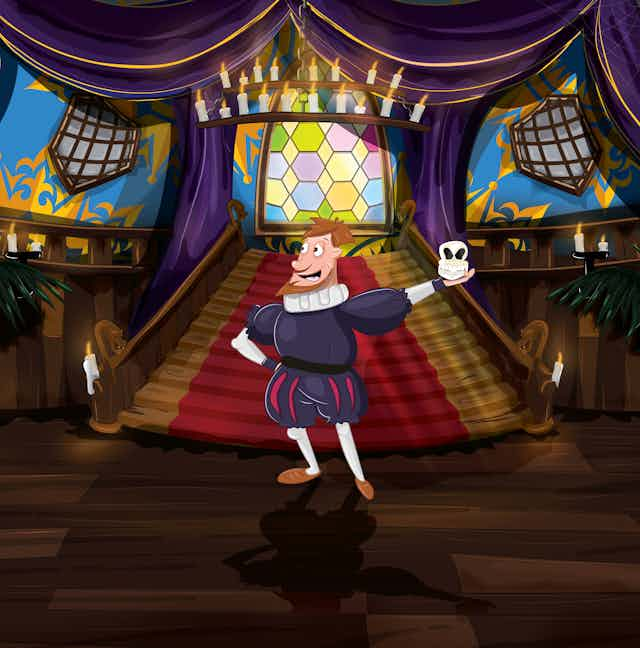If you’re not aware that on April 23 this year – in just a few weeks time – the world will be celebrating the 400th anniversary of Shakespeare’s death, then I can only think you have no access to any media whatsoever, social or otherwise. All sorts of celebrations – exhibitions, performances, talks, TV marathons, books, cakes, songs and so on – are already underway. And they, and more like them, will continue until the year’s end at least. Online, Twitter and Facebook are alive with almost endless posts with quotes, pictures, comments and clips.
The centre of these celebrations in Britain – and the major source of the endless stream of tweets and posts – is Stratford-upon-Avon, where the Shakespeare Birthplace Trust has much invested in this moment of celebration. This is natural enough of course, given that, as it says on the tin, Shakespeare was born and lived in this small country town and returned to it once his career in London was over, dying there in 1616.
The Birthplace Trust owns a number of houses that are associated with Shakespeare and his family and which are now museums open to the paying public. These include the house that is Shakespeare’s Birthplace, as well as Anne Hathaway’s Cottage (Shakespeare’s future bride), Mary Arden’s Farm (Shakespeare’s mother), Hall’s Croft (which according to the website was “the elegant home of Susanna Shakespeare and her husband, Dr John Hall”), and others. Tens of thousands of tourists from around the world flock to these houses and they are the very nucleus of this year’s festivities.

But I cannot remove the image of the Sleeping Beauty castle in Disneyland when I think of the various houses. Why? First, there is Shakespeare’s Birthplace on the street where we think Shakespeare was born – but there’s no evidence of which house. And there is no evidence whatsoever that Anne Hathaway, Mary Arden and Dr John Hall lived in the houses they’re attributed to. Hathaway lived in the village where the house is (we think). Arden’s Farm is in the village (we think) where Arden grew up. Hall’s Croft has nothing at all to do with Hall.
Given this, from where I stand, the houses in Stratford are in fact as imaginary as the castle in Disneyland, with the exception that at least the latter acknowledges its fictive nature. So, what is going on? Is there some massive scam going on here, located right in the heart of Shakespeare’s England? Of course not. But it does demonstrate the absurd amounts of mythmaking (and money) that form around these figures that we revere above all others. And sometimes (especially on anniversaries), it’s good to step back and acknowledge how creatively we celebrate these heroes.
Here’s another example. All this reminds me of that other Shakespearean tourist attraction in Verona, Italy: Juliet’s balcony. This is known not to be Juliet’s balcony – how could it be, the play is fiction – and yet tens of thousands of tourists visit it every year.

The original attraction of Juliet’s balcony lies in the enormous emotional and intellectual drama as it appears in Shakespeare’s play. It is the power of the play itself that is the attraction; a power that draws people to a bogus tourist attraction in order that they can in some way associate themselves with the story on a physical level. Juliet’s balcony is, in this sense a type of holy relic, much like the Turin shroud. Over time even those who do not “believe” are attracted to this famous relic: just as people ignorant of Shakespeare’s story are drawn to the balcony.
And such is the case – on a grand scale – with the various houses that are associated with Shakespeare in Stratford-upon-Avon. Many visitors know that the various houses are “fictive” – just like Disneyland’s castle – and yet still pay their money and immerse themselves in “Shakespeare’s England”. For they are entering holy places – tourism is, as we know, a form of modern pilgrimage – and communing with their literary saint, who was responsible for the plays that have moved them so much in their lives. Or, for many, they are a day out at the houses of a famous writer, even if they have not read the works. The Shakespeare Birthplace Trust merely provides them with the opportunity to do this (at a cost), in the same way that Disneyland provides visitors with the opportunity to see their cartoon heroes come to life.
When we celebrate the 400th anniversary of Shakespeare’s death we are celebrating a mythical figure much like Jesus (or Mickey Mouse). But like Jesus we do not celebrate the real man, as we know almost nothing about him. We celebrate Shakespeare as he is associated with the plays in the same way that we celebrate Jesus as he appears in the Gospels. The fact that the various houses in Stratford-upon-Avon are nothing to do with Shakespeare is beside the point. Their function is to perpetuate the myth, build the brand, continue the fiction of this great man, this holy icon. That is their function – not to be real, but to be “there”.

